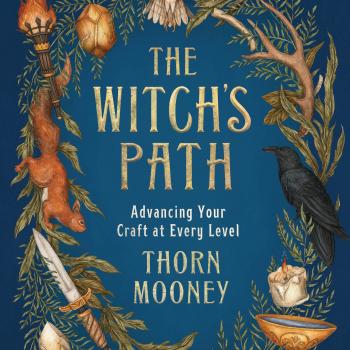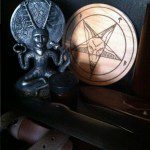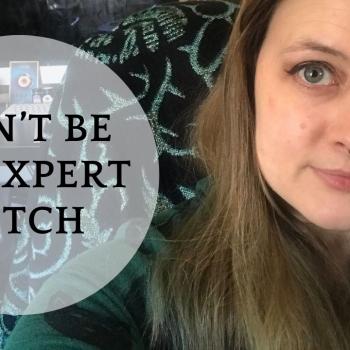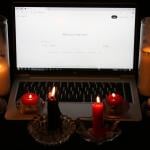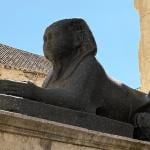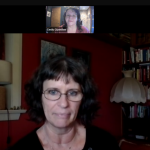One of the questions that I’m asked most frequently is this: what does your daily practice look like? It’s sort of a funny question. Behind it is this idea that religion is something that we necessarily do rather than something that we are, or something that we believe. And it’s not just a thing we do, it’s a thing we have to do with some regularity. It’s something we have to improve at. We “practice” it, after all. Whether or not we think witchcraft is a religion—and I wouldn’t presume to try defining “religion” for anyone, having spent enough time in grad school coming to the realization that scholars don’t really know what it is either—it seems pretty clear, most of the time, that it’s something we do.
So what am I doing from day to day to practice?
Rather than trying to fool any of you into believing that I have a coherent routine that resembles something you might see on Pinterest and that it’s never interrupted by jobs, illness, family drama, or malaise, I’ll tell you what I’ve been up to lately:
Skull Scrying
While at PantheaCon, I got to take a workshop from artist and fellow Patheos blogger Lupa Greenwolf on scrying with animal skulls. She goes over the specifics of her technique in a self-published book, and the workshop was merely an introduction (well, if such a thing can ever be said to be “mere”). The basic premise is this: that skull on your shelf (or on your altar, or in your garden, or wherever) belonged to a living creature with its own agency, its own instincts, fears, and, ultimately, its own experience of death. Some form of that critter’s essence—what we might think of as a soul—lingers after death, and it’s possible to interact with it. Using techniques reminiscent of more familiar forms of scrying, we can potentially share something of that individual’s experience and learn something valuable.
I do a lot with animal remains. As a long-distance hiker and a novice bowhunter, there are a fair number of animal encounters in my day to day. I also just love them (did you know I spent my first three years in college as a biology major?). There are skulls, pelts, claws, antlers, and other parts all over the house, some just because they’re beautiful and others because they play some role in my Craft. But all of them deserve care and respect.
So I was excited to expand my repertoire of magical techniques in providing that care and respect. If I can learn more about that animal—its life as well as its death—directly from the animal, then that’s something that’s worth pursuing. It also begs a lot of questions about other kinds of Craft work (working with fetches, familiars, and other kinds of spirits, to name some of the most obvious). So lately, I’ve been spending time before bed practicing skull scrying. Aside from the magical practice, it provides the added benefit of relaxing me before sleep. It also doesn’t require much beyond the skull itself, so I don’t have to worry about an elaborate ritual, other tools, etc. Whether I spend five minutes or forty, I’ve gotten something out of the experience each time.
Writing
Whether or not you think writing counts as witchcraft really depends on who you are and why you’re writing. I’ve found that writing is the best way for me to process. It also enables me to alter my mood, explore possibilities, wrestle with conflict, and visualize. Other people meditate. I write. Is it witchcraft? It is when I do it.
To me, writing is a sacred act. Some witches are great teachers, great coven leaders, great magicians, or great theologians. I don’t feel like any of those things. What I have to offer my tradition is my writing. Who knows? Maybe what I write will really have some impact somewhere someday, even if it’s just the story of one priestess finding her way as best she can. I’m entranced by the idea that writers change the world. One essay, one poem, one letter, one long-lost diary changes the practice for someone. Maybe creates a whole movement. It happens, over and over again. I’m not writing with that as my goal—I’m not quite that vain. But I do write with the understanding that people will read what I put out there and it might have some real impact, for good or ill. I take that to heart and usually take a lot of care with my words. For some people, I might be the only Gardnerian they ever read, so I’m representing something precious, even if I shouldn’t be.
So yeah. It’s part of my witchcraft practice.
(As an aside, I also magic the shit out of my ink, my fountain pens, and my notebooks.)
All the Sports
Somewhere, somehow, I became an athlete. Believe me, everyone in my life who’s known me for more than a couple of years is totally mystified. I’m training for my first half-Marathon in April, and I have quickly become enamored with HEMA (Historical European Martial Arts), studying longsword with a club here in Charlotte and working independently on Viking sword (which thrills my mother). And, of course, there’s archery, my real love. A big chunk of my free time is dedicated to some variation on working out.
Is it witchcraft? Not really, for me. But some of it is devotional. My practice of archery is very much about my relationship with Herne the Hunter and my own Horned God of death and rebirth. Ultimately, I’m practicing to take a deer this upcoming fall. It’s been part of the plan since the beginning. For me, this is the ultimate religious experience in the making. I can’t draw an arrow without thinking about that sacred connection between hunter and prey, death and resurrection. Maybe it’s not witchcraft in the way we usually think of witchcraft, but it is part of my devotional practice (and further evidence for why I think the divide between “Pagans” and “Polytheists” is so strange—as though those are mutually exclusive).
I can’t really explain the sword fighting and the running (which is almost compulsive). Part of it is just that it makes me feel in tune with my body. I like myself more this way. It gives me confidence and makes me feel powerful. And that in turn makes for more effective witchcraft. HEMA has the added benefit of encouraging me to explore my own cultural roots. I can get my nerd on at the same time. And archery helps me to connect with the Southern culture that surrounds me. I share a common language with people I’d never spend time with otherwise (Conservative, Christian, working class, rural folks who are usually cast as our opponents—which it turns out is a gross oversimplification on the part of many Pagans).
So sports are part of my daily practice. They don’t entail sitting at an altar, but I think of that sweat and blood as an offering. In any case, it makes me a stronger person, and therefore a more effective witch.
Foxfire
I’ve already written about how much of my Wiccan practice revolves around my coven. Being a coven leader sounds sexy, but it mostly means a lot of e-mails and vacuuming. I love it and it’s critical to the survival of our tradition, but it’s definitely not for everyone. It’s not burning incense and chanting over candles, or dancing naked under an October moon through dew-kissed grass or whatever. It’s long phone conversations and crying over beer and constantly feeling like you’re fucking up. It’s messy and amazing. Is it witchcraft? It seems like the answer should be obvious, but I still think most people would be surprised.
So my daily practice doesn’t entail hours of meditation or elaborate rituals with lots of tools. It’s conscious. I decide to make things relevant. But I also seek things out. Every part of my life isn’t magical, but I am taking stuff that could be mundane and finding profound meaning in it. And it changes from week to week and season to season. You have to construct your own meaning sometimes. Maybe all the time.
Is it witchcraft? That depends. But does it make me a more effective witch? Hell yes.



